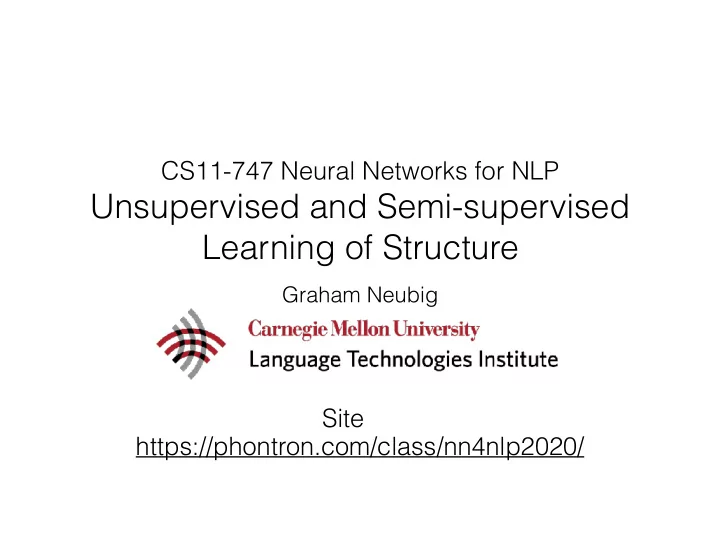

CS11-747 Neural Networks for NLP Unsupervised and Semi-supervised Learning of Structure Graham Neubig Site https://phontron.com/class/nn4nlp2020/
Supervised, Unsupervised, Semi-supervised • Most models handled here are supervised learning • Model P(Y|X), at training time given both • Sometimes we are interested in unsupervised learning • Model P(Y|X), at training time given only X • Or semi-supervised learning • Model P(Y|X), at training time given both or only X
Learning Features vs. Learning Structure
Learning Features vs. Learning Discrete Structure • Learning features, e.g. word/sentence embeddings: this is an example • Learning discrete structure: this is an example this is an example this is an example this is an example • Why discrete structure? • We may want to model information flow differently • More interpretable than features?
Unsupervised Feature Learning (Review) • When learning embeddings, we have an objective and use the intermediate states of this objective • CBOW • Skip-gram • Sentence-level auto-encoder • Skip-thought vectors • Variational auto-encoder
How do we Use Learned Features? • To solve tasks directly (Mikolov et al. 2013) • And by proxy, knowledge base completion, etc., to be covered in a few classes • To initialize downstream models
What About Discrete Structure? • We can cluster words • We can cluster words in context (POS/NER) • We can learn structure
What is our Objective? • Basically, a generative model of the data X • Sometimes factorized P(X|Y)P(Y), a traditional generative model • Sometimes factorized P(X|Y)P(Y|X), an auto- encoder • This can be made mathematically correct through variational autoencoder P(X|Y)Q(Y|X)
Clustering Words in Context
A Simple First Attempt • Train word embeddings • Perform k-means clustering on them • Implemented in word2vec (-classes option) • But what if we want single words to appear in different classes (same surface form, different values)
Hidden Markov Models • Factored model of P(X|Y)P(Y) • State → state transition probabilities • State → word emission probabilities P T (JJ|<s>) * P T (NN|JJ) * P T (NN|NN) * P T (NN|LRB) * … <s> JJ NN NN LRB NN RRB … </s> Natural Language Processing ( NLP ) … P E (Natural|JJ) * P E (Language|JJ) * P E (Processing|JJ) * …
Unsupervised Hidden Markov Models • Change label states to unlabeled numbers P T (13|0) * P T (17|13) * P T (17|17) * P T (6|17) * … 0 13 17 17 6 12 6 … 0 Natural Language Processing ( NLP ) … P E (Natural|13) * P E (Language|17) * P E (Processing|17) * … • Can be trained with forward-backward algorithm
Hidden Markov Models w/ Gaussian Emissions • Instead of parameterizing each state with a categorical distribution, we can use a Gaussian (or Gaussian mixture)! 0 13 17 17 6 12 6 … 0 … • Long the defacto-standard for speech • Applied to POS tagging by training to emit word embeddings by Lin et al. (2015)
A Simple Approximation: State Clustering (Giles et al. 1992) • Simply train an RNN according to a standard loss function (e.g. language model) • Then cluster the hidden states according to k- means, etc.
Featurized Hidden Markov Models (Tran et al. 2016) • Calculate the transition/emission probabilities with neural networks! • Emission: Calculate representation of each word in vocabulary w/ CNN, dot product with tag representation and softmax to calculate emission prob • Transition Matrix: Calculate w/ LSTMs (breaks Markov assumption)
Problem: Embeddings May Not be Indicative of Syntax (He et al. 2018) adjective adverb noun singular noun proper noun plural verb base verb gerund verb past tense verb past participle verb 3rd singular cardinal number
Recommend
More recommend